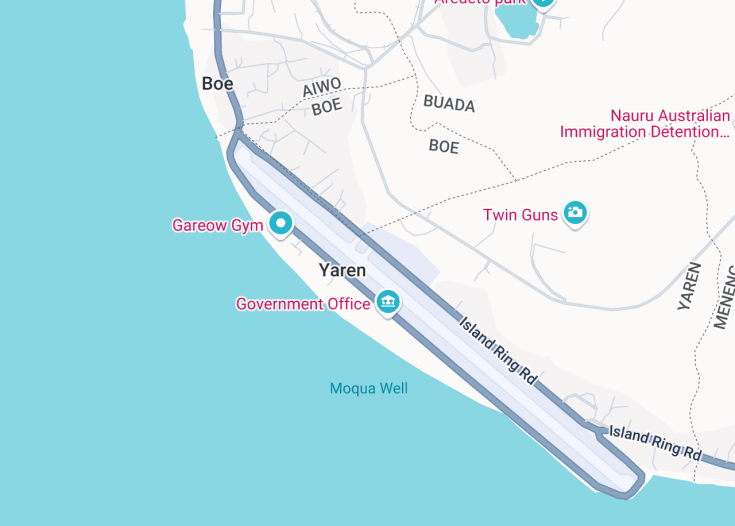Yaren District serves as the de facto capital of Nauru, an island nation in the South Pacific Ocean. This district, although modest in size, is steep in history and culture, playing a pivotal role in Nauru’s administration and governance. Visitors can explore remnants of phosphate mining, which dramatically shaped the island’s landscape and economy. Noteworthy sites include the Parliament House and the Nauru International Airport, alongside several World War II relics. Yaren also offers intriguing natural attractions like the Moqua Well and the lush tropical vegetation surrounding its vicinity.
Be sure to visit during the cooler months from May to October to avoid the intense heat and humidity typical of the tropical climate.
Consider scheduling a guided tour through Yaren to capture the rich history and environmental context offered by local experts.
Top things to do & see in Yaren District
Select the following sights and activities to discover best tickets and tours available in Yaren District.
Yaren District: Heart of Nauru
| Country | Nauru |
| Time in Yaren District | GMT+12 |
| Language spoken | Nauruan |
| Population | 747 (World Population Review, 2023) |
| Currency | Australian Dollar (AUD) |
| Airports | Nauru International Airport (2 mi / 3.22 km) |
Yaren District s the silent watchdog of Nauruan culture and politics, encapsulating the nation’s history, governmental affairs, and serene Pacific beauty. Being the de facto capital of Nauru, Yaren hosts a number of pivotal government buildings and foreign embassies. The district lies at the southern tip of the island, highlighting its geographical importance for Nauru’s communication with the outer world. Home to the awe-inspiring Moqua Well cave and Yaren Bay, this district renders a soothing blend of nature and calmness against the grandiose backdrop of Pacific waves.
Where is Yaren District?
Located in the southern part of Nauru, Yaren District serves as the administrative heart of the island.
Distances:
| Route | Distance by car | Time by car |
|---|---|---|
| Aiwo to Yaren | 3 mi (4.8 km) | 8 min |
| Buada to Yaren | 2 mi (3.2 km) | 5 min |
| Anabar to Yaren | 6 mi (9.7 km) | 12 min |
What is Yaren District famous for?
Yaren is renowned for hosting Nauru’s most crucial governmental institutions. It also features prominent natural landmarks like the Moqua Well, a limestone cave holding a freshwater lake.
History
Pre-Colonial Period: Before 1798
The history of Yaren District, situated within the island nation of Nauru, begins long before the area was officially recognized or named. The indigenous Nauruan people, believed to have settled the island around 1000 BC, were the region’s first inhabitants. These early settlers developed a unique culture, characterized by matrilineal descent and complex social structures. They survived primarily through fishing, small-scale agriculture, and trading with other Micronesian islands.
Colonial Intrusions: 1798-1968
The first known European to sight Nauru was John Fearn in 1798 aboard the British whaling ship Hunter, marking the beginning of the colonial era. However, Nauru remained relatively untouched by European influence until the late 19th century. In 1888, Germany annexed Nauru, integrating it into their Pacific protectorate and later exploiting its phosphate resources, which were discovered in 1900. Following World War I, the League of Nations transferred mandate over Naurus to Australia, New Zealand, and the United Kingdom. The extensive phosphate mining continued under these administrations, drastically altering the island’s landscape and its socio-economic dynamics.
Post-Independence Era: 1968-Present
Yaren’s modern significance began to take shape with Nauru’s independence in 1968. It was established as an official district and eventually became the seat of Nauru’s government. As the location of the Parliament House, the Supreme Court, and the international airport, Yaren stands at the core of Nauruan political and economic life. Today, apart from its administrative functions, Yaren is notable for encompassing part of the phosphate plateau and hosting relics of its diverse history, including remnants from its days as a German and later a British-Australian-New Zealand mandate.
Visit Yaren District
What to see and do in Yaren District, Nauru
Yaren District offers a unique blend of historical sites and natural beauty. Visitors can explore the remains of the phosphate mining industry which markedly shaped Nauru’s landscape and economy. The district houses the Parliament House, a modern structure where the nation’s important decisions are made, open to public during non-sessional periods.
For nature enthusiasts, the Moqua Well, a freshwater lake in a secondary cave, is a significant attraction. Additionally, the reef cliffs and beaches along Yaren’s coastline provide opportunities for relaxation and sea-front enjoyment.
Annual Festivals and Events
Yaren, though small, hosts several culturally significant events throughout the year. One of the most notable is Angam Day, celebrated every October 26th. This day commemorates the survival and resilience of the Nauruan people, marking occasions when the population has rebounded back to 1,500, considered a viable number for cultural sustainability. The event includes traditional music, dance, and communal feasting.
Best time to visit Yaren District
The optimal time to visit Yaren District in Nauru is during the cooler, drier months from July to September. During this period, the weather is more conducive to outdoor activities and exploring the island.
Is Yaren District worth visiting?
Yaren District offers a unique glimpse into Nauru’s cultural, historical, and natural landscapes. It is particularly appealing for those interested in Pacific Island history and culture. However, potential visitors should consider the limited tourism infrastructure and the environmental damages caused by historical phosphate mining. While these factors may pose challenges, the opportunity to experience one of the least visited countries in the globe provides a rare and enriching travel experience for adventurous tourists.










